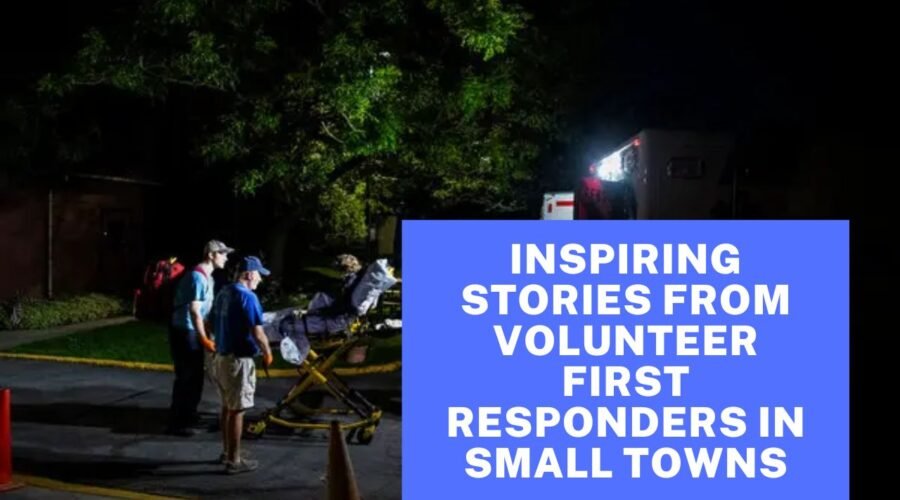Inspiring Stories From Volunteer First Responders In Small Towns
In thousands of rural communities, volunteer first responders—firefighters, EMTs, and search-and-rescue teams—are the first to arrive when disaster strikes.
They leave dinner tables, jobs, and warm beds to answer tones at 2 a.m.
With limited budgets, long distances, and rugged terrain, these neighbors-turned-responders deliver professional-grade care and life-saving service where every minute counts.
A CPR Save On A Snowy Back Road
One winter night, a small-town crew was paged to a cardiac arrest on a farm road slick with ice. The first-arriving volunteer began CPR within minutes, using an AED from the truck to deliver a shock.
By the time the transporting unit arrived, the patient had regained a pulse.
Weeks later, the entire town gathered at the fire hall for a simple ceremony—no fanfare, just a grateful handshake and a reminder that fast bystander CPR and nearby volunteers can change outcomes.
Wildfire Lines And Wind-Driven Grass Fires
On the plains, volunteer firefighters battle fast-moving grass fires that can jump roads in seconds.
Mutual-aid pagers light up across county lines; brush trucks roll, and farmers bring water tenders to the edge of the flames.
With coordinated radio traffic, safety lookouts, and firebreaks cut by local equipment, volunteers protect homes, barns, and livelihoods—often in the same neighborhoods where they grew up.
Tornado Aftermath- Stabilize, Search, And Rebuild
When storms shred roofs and scatter power lines, volunteer EMS and fire units pivot from rescue to rehab and wellness checks.
They mark cleared homes, deliver medications for those who can’t travel, and set up warming or cooling stations at community centers.
The work stretches far beyond the first 24 hours; volunteers return for days to remove debris, check generators, and help families navigate insurance and cleanup.
Small-Town Impact At A Glance
| Location / Setting | Call Type | Volunteer Actions | Outcome / Impact |
|---|---|---|---|
| Rural Farm Road (Winter) | Cardiac Arrest | Immediate CPR and AED shock by first-arriving volunteer | Pulse regained before transport; patient discharged home |
| Prairie Community (Autumn) | Wind-Driven Grass Fire | Brush trucks, farmer water tenders, mutual aid | Homes and livestock protected; fire stopped at road break |
| Tornado-Hit Town (Spring) | Severe Weather Aftermath | Door-to-door checks, rehab stations, meds delivery | Faster recovery; vulnerable residents kept safe and warm |
| Mountain Hamlet (Summer) | Lost Hiker SAR | Ground teams, K-9, coordinated grid search | Hiker located before nightfall; minor injuries treated |
Note: Table illustrates typical, real-world scenarios seen across small towns.
Training, Gear, And The Power Of Preparedness
Small-town responders meet national standards for incident safety, medical protocols, and radio operations.
Many hold EMT, Paramedic, and Firefighter I/II certifications, and train on extrication, wildland tactics, water rescue, and STOP THE BLEED skills.
Departments stretch budgets to maintain PPE, SCBA, AEDs, and rescue tools. Grants, community fundraisers, and city/county support help keep rigs rolling and gear current.
Family, Work, And The Silent Sacrifice
Volunteering is a family commitment. Spouses watch the clock during storms; kids know the sound of the pager.
Employers who allow on-call flexibility or shift swaps are quiet heroes, too.
The balance is tough—late nights, high emotion, and missed events—but the payoff is tangible: lives saved, homes protected, and a stronger town.
Lessons That Keep Residents Safer
- Learn CPR And AED Use: Early bystander CPR doubles or triples the odds of survival in sudden cardiac arrest.
- Mark Your Address Clearly: Visible numbering shortens response time on dark rural roads.
- Create A Family Plan: Share medications, allergies, and emergency contacts in a Go Kit.
- Support Your Department: Donate, attend fundraisers, and ask leaders about grant opportunities or equipment needs.
How To Get Involved (Even If You Don’t Fight Fires)
You don’t need to ride the engine to be essential. Departments need logistics, rehab (hydration and monitoring for crews), radio/IT, public education, and fundraising help.
Photographers, mechanics, accountants, and teachers all play roles that keep the mission moving. Consider joining as auxiliary, support, or explorer/cadet.
Small towns run on neighbors helping neighbors—and nowhere is that clearer than in the stories of volunteer first responders.
From icy-road CPR saves to wind-driven grass fire stops and careful storm-recovery days, their service is skilled, disciplined, and deeply human.
These men and women are proof that with training, teamwork, and community backing, ordinary people can deliver extraordinary outcomes.
If your town relies on volunteers, now is the time to learn CPR, join a support role, or simply ask, “What do you need?” Your next small act could be the difference someone is waiting for.
FAQs
What Qualifies Someone To Serve As A Volunteer First Responder?
Most departments require a background check, a valid driver’s license, and completion of initial training (such as EMT or Firefighter I/II). Ongoing continuing education, drills, and fitness are part of staying response-ready.
How Can A Resident Help If They Can’t Serve On The Front Line?
Support with fundraising, logistics, rehab, grant writing, station maintenance, or community CPR/AED classes. You can also help by making sure your address is visible and keeping driveways clear for apparatus.
What Are The Biggest Challenges For Small-Town Volunteer Agencies?
Funding for gear and training, recruitment and retention, and long response distances. Communities that invest in equipment, promote public education, and recruit across ages and professions see the best results.


Leave a Reply